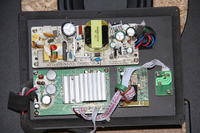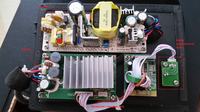Hi
The sub mentioned in the topic was given to me as a freebie for my TV. For half a year it was lying unused, because the TV software is basically a collection of bugs and the TV did not feel like making a connection. After a recent upgrade the connection to the sub was able to be established and I decided to see if it was worth using it at all. I say straight away that I wasn't expecting a bump in the liver from this device. He's only there to assist the TV speakers in reproducing low tones when listening to a normal programme not too loudly. For movies and music I have an external amplifier with decent speakers.
After pairing the sub with the TV the former started to make some sounds. Sounds that are best described by the word "farting". It sounds hopeless. The sub not only does not improve anything in the listening, it spoils it. It is simply impossible to listen to. Quiet farting, in addition I think out of phase gives the effect of tiring reverberation. As if a lost pad is smashing on the diaphragm of some speaker.
There was nothing left to do but to see this invention from the inside.

From the outside, a rather large speaker cover and a bassreflex opening plugged with a sponge.
After removing the loudspeaker cover a slight surprise:

And then a glance at the electronics:

I don't know whether the fact that it sounds so bad is due to the small loudspeaker, the amplifier used or maybe transmission problems.
For the time being I have only tested the speaker. I hooked it up to a regular stereo amplifier. It plays poorly. There is hardly any bass, but no farting either. I plan to power a regular speaker with this amplifier. Maybe I will learn something about its quality. Ultimately I would like to build a new sub if possible using the original cabinet and communication module.
What do you guys think? Any ideas?
The sub mentioned in the topic was given to me as a freebie for my TV. For half a year it was lying unused, because the TV software is basically a collection of bugs and the TV did not feel like making a connection. After a recent upgrade the connection to the sub was able to be established and I decided to see if it was worth using it at all. I say straight away that I wasn't expecting a bump in the liver from this device. He's only there to assist the TV speakers in reproducing low tones when listening to a normal programme not too loudly. For movies and music I have an external amplifier with decent speakers.
After pairing the sub with the TV the former started to make some sounds. Sounds that are best described by the word "farting". It sounds hopeless. The sub not only does not improve anything in the listening, it spoils it. It is simply impossible to listen to. Quiet farting, in addition I think out of phase gives the effect of tiring reverberation. As if a lost pad is smashing on the diaphragm of some speaker.
There was nothing left to do but to see this invention from the inside.

From the outside, a rather large speaker cover and a bassreflex opening plugged with a sponge.
After removing the loudspeaker cover a slight surprise:

And then a glance at the electronics:

I don't know whether the fact that it sounds so bad is due to the small loudspeaker, the amplifier used or maybe transmission problems.
For the time being I have only tested the speaker. I hooked it up to a regular stereo amplifier. It plays poorly. There is hardly any bass, but no farting either. I plan to power a regular speaker with this amplifier. Maybe I will learn something about its quality. Ultimately I would like to build a new sub if possible using the original cabinet and communication module.
What do you guys think? Any ideas?




